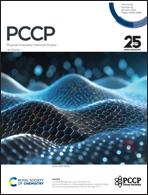Effect of GM1 concentration change on plasma membrane: molecular dynamics simulation and analysis†
Abstract
Ganglioside GM1 is a class of glycolipids predominantly located in the nervous system. Comprising a ceramide anchor and an oligosaccharide chain containing sialic acid, GM1 plays a pivotal role in various cellular processes, including signal transduction, cell adhesion, and membrane organization. Moreover, GM1 has been implicated in the pathogenesis of several neurological disorders, such as Parkinson's disease, Alzheimer's disease, and stroke. In this study, by creating a neural cell model membrane simulation system and employing rigorous molecular models, we utilize a coarse-grained molecular dynamics approach to explore the structural and dynamic characteristics of multi-component neuronal plasma membranes at varying GM1 ganglioside concentrations. The simulation results reveal that as GM1 concentration increases, a greater number of hydrogen bonds form between GM1 molecules, resulting in the formation of larger clusters, which leads to reduced membrane fluidity, increased lipid ordering, decreased membrane thickness and surface area and higher levels of GM1 dissociation. Through a meticulous analysis, while considering GM1's structural attributes, we offer valuable insights into the structural and dynamic traits of the cell membrane. This study provides a robust methodology for exploring membrane characteristics and enhances our comprehension of GM1 molecules, serving as a resource for both experimental and computational researchers in this field.



 Please wait while we load your content...
Please wait while we load your content...